Dazzling Your Garden with Enchanting Purple Flowers Beloved by Hummingbirds
If you’re looking to create a unique and captivating statement garden that will attract hummingbirds, why not opt for an array of stunning purple flowers? While hummingbirds aren’t solely attracted to red flowers, it’s the nectar produced by the plants that piques their interest, making them drawn to various colored flowers.
Before diving into the world of purple plants, it’s crucial to consider your area’s plant hardiness and ensure that the selected varieties can thrive in your specific zone.
While these plants come in an assortment of colors, the purple varieties are particularly favored by hummingbirds, making them the perfect addition to your yard to invite these delightful creatures.
1. Enchanting Foxglove
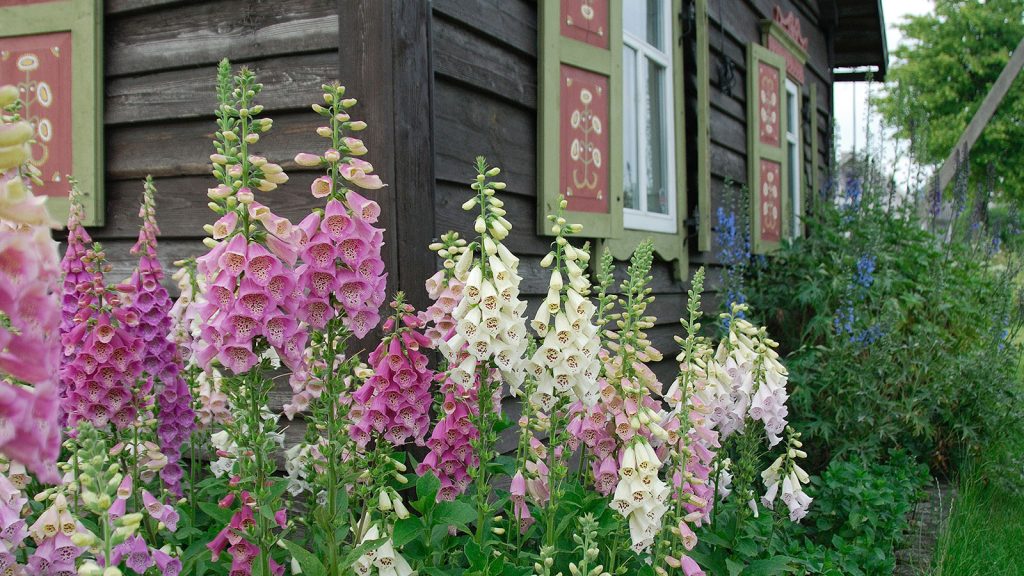
Foxglove, a magnificent woodland flower, showcases tall stems adorned with bell-shaped blossoms. Its shade-tolerant nature and long, inviting blooms make it accessible for hummingbirds with their lengthy bills and tongues to extract nectar. Foxgloves are biennial plants, requiring planting in consecutive years as they don’t produce flowers in their first year and eventually perish after their second year of flowering. However, they self-seed readily, ensuring a dramatic display for years to come. Planting foxgloves from seeds is a breeze during late spring or late summer when temperatures are cooler.
Common Name: Foxgloves
Scientific Name: Digitalis
Growing Zones: 4 – 8
Sun: Full sun to partial shade
Soil: Slightly acidic, well-drained but moist
Colors: Purple, pink, white
Height: 5 feet
Plant Type: Biennials
2. Vibrant Impatiens
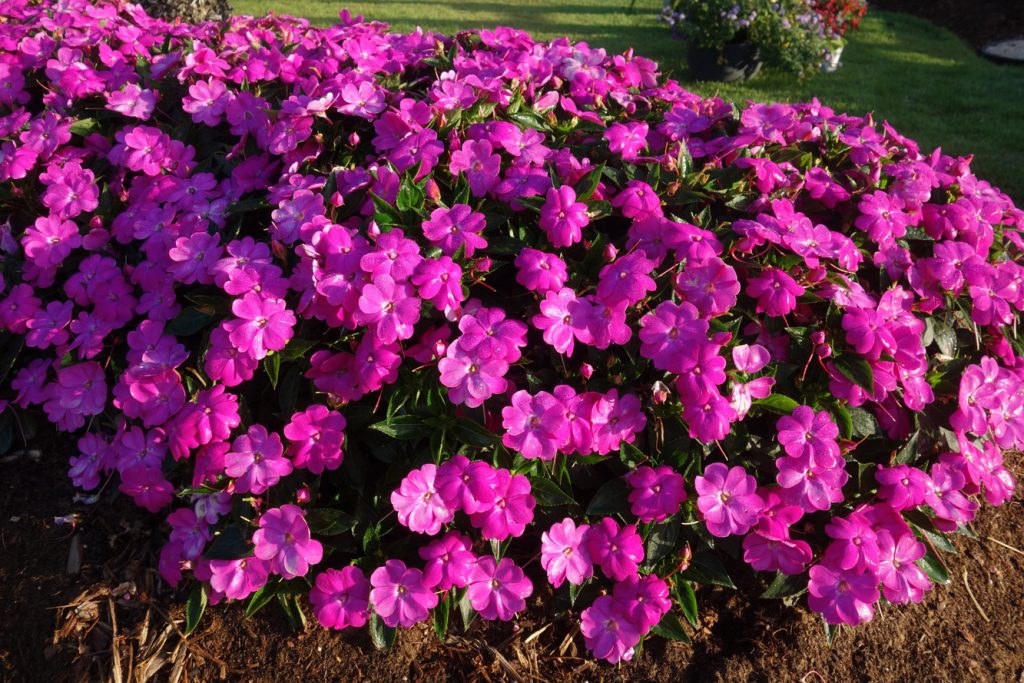
Bright and colorful annuals such as Impatiens are perfect for illuminating shady areas while also attracting hummingbirds. They thrive in moist, well-draining soil and deep shade, making them ideal for hanging on porches. While you can purchase young plants in trays from nurseries, growing them from seeds is also an option. Start them indoors about 10 weeks before the last frost, as they take time to flower. Additionally, cuttings can be taken in autumn and grown indoors until the frost subsides.
Common Name: Impatiens, jewelweed, touch-me-not, snapweed, patience
Scientific Name: Impatiens
Growing Zones: 2 – 11
Sun: Shade or partial shade
Soil: Rich, well-draining
Colors: Red, pink, purple, yellow, coral
Height: 6 – 36 inches
Spread: 1 – 3 feet
Plant Type: Annual
3. Majestic Petunias
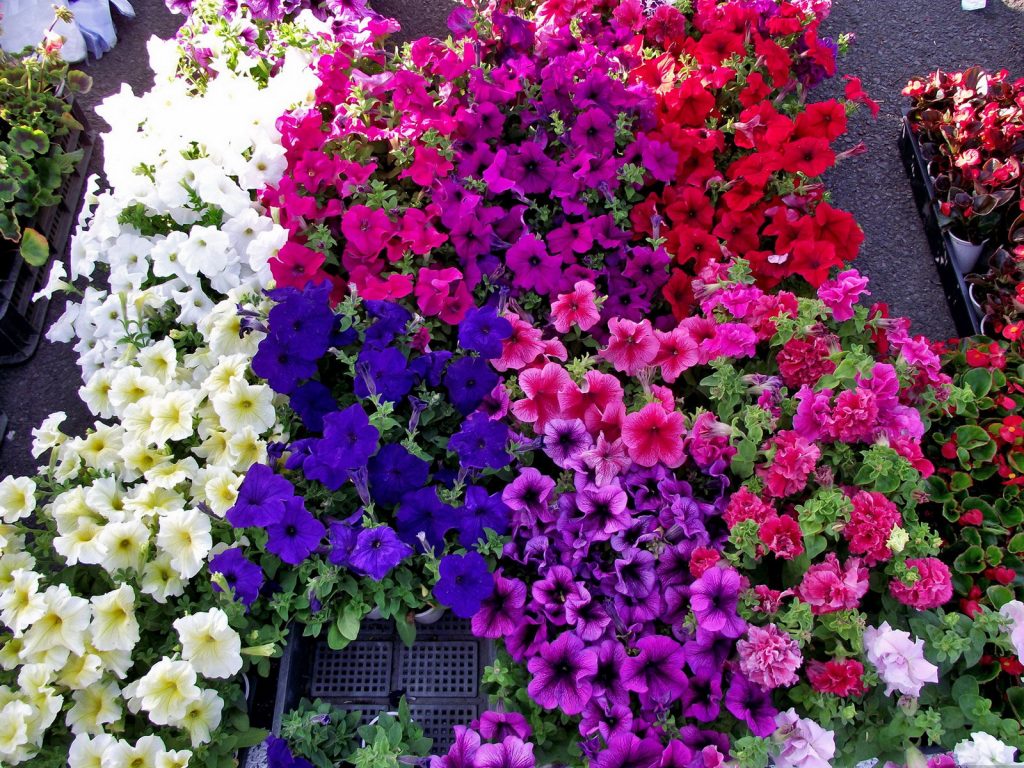
Petunias, affordable and bursting with vibrant colors, are easy to grow in sunny locations, making them an excellent choice for containers. These flowers create a bountiful display, cascading gracefully out of pots and containers. While you can purchase young plants in flats, growing them from seeds is also an option. Start them 10 weeks before the last frost and transplant them once the risk of frost has passed. Petunias are fairly heat-tolerant, but they benefit from regular watering. Pruning them to about half their height prevents them from becoming thin and leggy. Brighter colors such as reds and pinks are particularly appealing to hummingbirds.
Common Name: Petunias
Scientific Name: Petunias
Growing Zones: 9 to 11
Sun: Full sun
Soil: Well-drained, moist soil
Colors: Red, pink, white, blue, purple
Height: 6 – 18 inches
Spread: 18 inches to 4 feet
Plant Type: Tender Perennial, Annual
4. Captivating Hyacinth Bean

The Hyacinth Bean, also known as Lablab Purpureus, is a bean vine belonging to the Fabaceae family. Originating from Africa, this plant is cultivated for food in Asia and is often used as an ornamental plant in the United States. With its pinkish-lavender blossoms and captivating purple seed pods, it adds a touch of allure to any garden. Hyacinth beans can reach impressive heights of up to 25 feet when securely supported by trellises or other structures. The flowers bloom in summer through fall, forming clusters along the stalks in colors ranging from white and pink to lavender and purple. However, the seeds within the pods are poisonous and should not be ingested. Hummingbirds are particularly fond of these vibrant purple flowers, and their care is surprisingly easy. Providing them with ample sunlight, proper support, and regular watering during the initial growth stages will ensure their prosperity.
Common Name: Hyacinth Bean, Indian Bean, Egyptian bean, bataw, Australian pea
Scientific Name: Lablab Purpureus
Growing Zones: 4 – 9
Sun: Full sun (no partial shade)
Soil: Well-draining soil
Colors: White, pink, lavender, purple
Height: 10 – 25 feet
Spread: 3 – 6 feet
Plant Type: Annual
5. Enigmatic Clematis
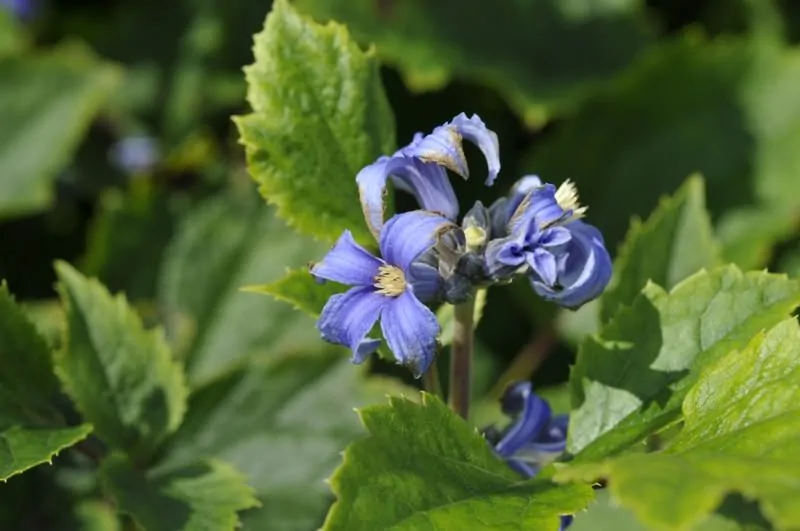
Clematis, a group of flowering vines from the buttercup family, Ranunculaceae, are adored for their diverse colors and ability to attract hummingbirds and other pollinators to your garden. Originating from Japan and China, these ornamental plants offer a plethora of options suitable for different climates. With their large and small star-shaped flowers, they come in an array of colors such as white, yellow, pink, blue, and purple. The flowering period depends on the variety, ranging from spring to late summer. Clematis prefer full sun, although they require consistently moist soil to thrive. Select a suitable support system based on the desired height of your clematis, whether it be an arbor, trellis, or fence. These remarkable flowers provide a feast for the eyes, attracting not only hummingbirds but also butterflies to your garden.
Common Name: Clematis, woodbine, old man’s beard
Scientific Name: Clematis
Growing Zones: 4 – 8
Sun: Full sun
Soil: Moist, well-drained soil
Colors: White, yellow, pink, blue, purple
Height: 2 – 5 feet, 8 – 12 feet, 20 – 30 feet
Spread: 2 – 6 feet wide
Plant Type: Perennial, Woody deciduous, herbaceous, and evergreen vines
6. Exquisite Passionflower
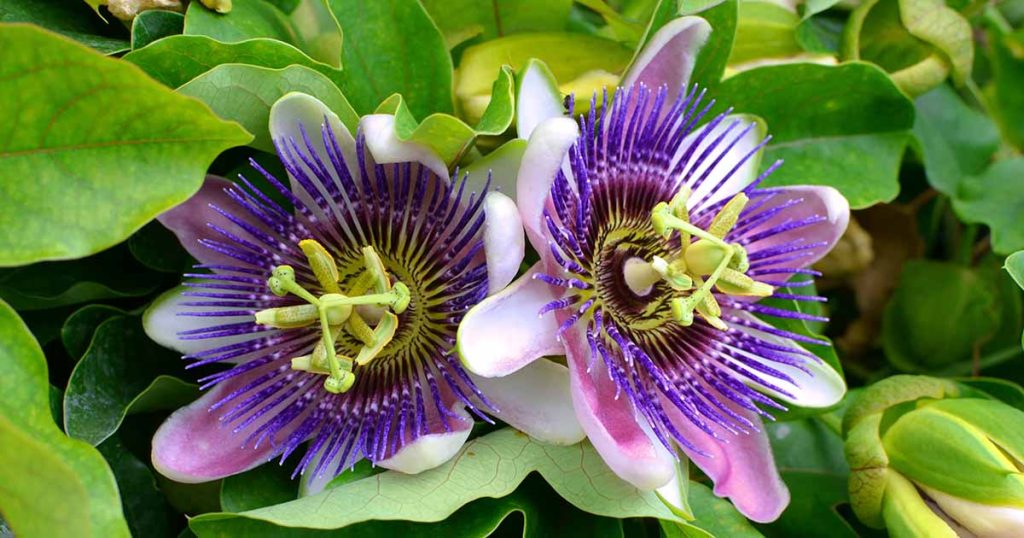
Passionflowers, also known as passion vines, belong to the Passiflora genus, comprising approximately 550 species of flowering plants. These unique and exotic flowers attract hummingbirds and bees with their intricate floral structures. Passionflowers come in various colors, including white, pink, red, purple, and blue. They thrive in full sun, requiring at least four hours of direct sunlight daily. Well-drained, organic soil is essential for their growth. Passionflowers bear fruit after successful pollination, with some varieties being edible. However, caution should be exercised as some parts of the plant are toxic. Passionflowers are relatively easy to care for, needing regular watering during their establishment phase.
Common Name: Passionflower, maypop, true passionflower, wild apricot, wild passion vine
Scientific Name: Passiflora
Growing Zones: 5 – 9
Sun: Full sun (at least 4 hours)
Soil: Well-drained, organic soil
Colors: White, pink, red, purple, blue
Height: 6 – 30 feet tall
Spread: 3 – 6 feet wide
Plant Type: Perennial vine
7. Radiant Rhododendron
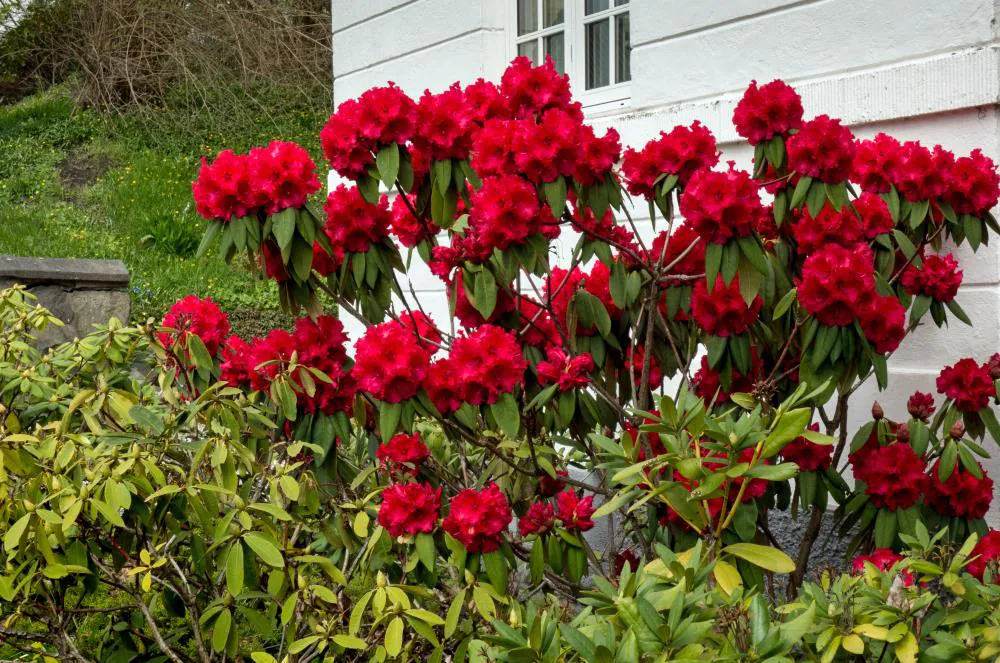
Rhododendrons, belonging to the heather family, Ericaceae, encompass a vast group of woody plants comprising approximately 1,000 species. Rhododendrons are sought after for their vibrant flowers and ability to thrive as evergreen shrubs. Distinguishing them from their similar counterparts, azaleas, can be done by observing the number of stamens and flower shape. Rhododendrons feature bell-shaped flowers with ten stamens, while azaleas showcase funnel-shaped flowers with five stamens. Rhododendrons range from small shrubs to towering trees and are commonly used in ornamental landscaping. Planting them during early spring or fall, depending on your climate, is crucial for successful growth. Rhododendrons prefer partial shade, well-drained acidic soil, and regular irrigation. These stunning flowers, available in shades of pink, purple, red, white, and yellow, are sure to attract hummingbirds to your garden.
Common Name: Rhododendron
Scientific Name: Rhododendron
Growing Zones: 4 – 11
Sun: Partial shade
Soil: Well-drained, acidic
Colors: Pink, purple, red, white, yellow
Height: 18 inches to 50 feet
Spread: 2 – 3 feet
Plant Type: Perennial
8. Native Buddleia – Butterfly Bush
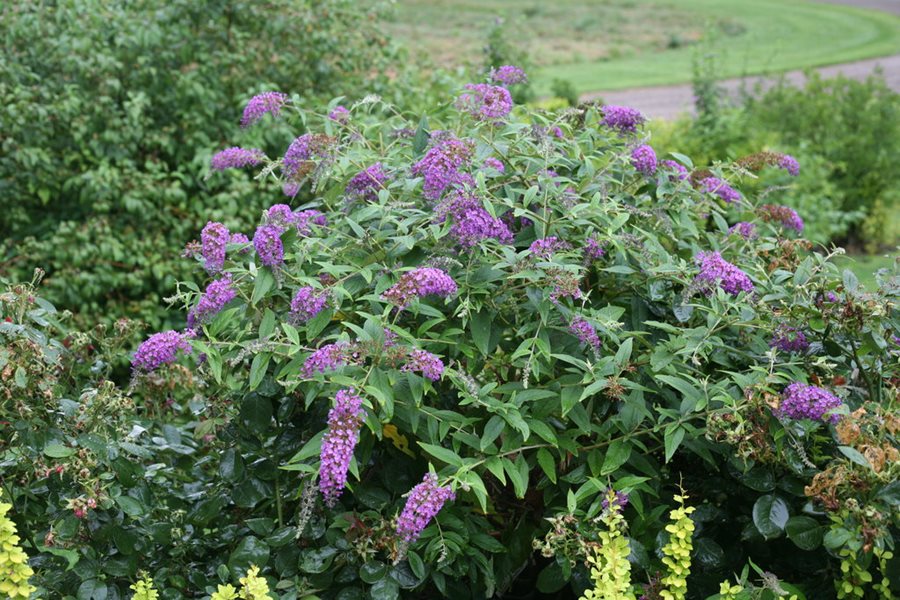
Buddleia, commonly known as the butterfly bush, enchants with its striking purple, red, pink, white, and yellow flowers, making it a favorite among gardeners aiming to attract butterflies and hummingbirds. The plant derives its name from the butterflies that flock to its nectar-rich flowers. While the well-known Buddleia davidii variety is considered invasive in several regions, sterile and native alternatives exist, such as the Rio Grande Butterfly Bush, Wand Butterfly Bush, Escobilla Butterfly Bush, and Fountain Butterfly Bush. These alternatives can be cultivated in pots or backyards, with dwarf varieties reaching heights of only 8 to 10 feet. Butterfly bushes are low-maintenance, drought-tolerant plants that require full sun and regular watering during their establishment period. Proper pruning and careful selection of non-invasive varieties ensure a delightful garden for both hummingbirds and butterflies.
Common Name: Buddleia, butterfly bush, summer lilac
Scientific Name: Buddleja
Growing Zones: 5 – 10
Sun: Full sun
Soil: Well-drained
Colors: Pink, purple, red, white, yellow
Height: 4 to 10 feet
Spread: Up to 5 feet
Plant Type: Perennials, Evergreen
9. Alluring Cape Myrtle
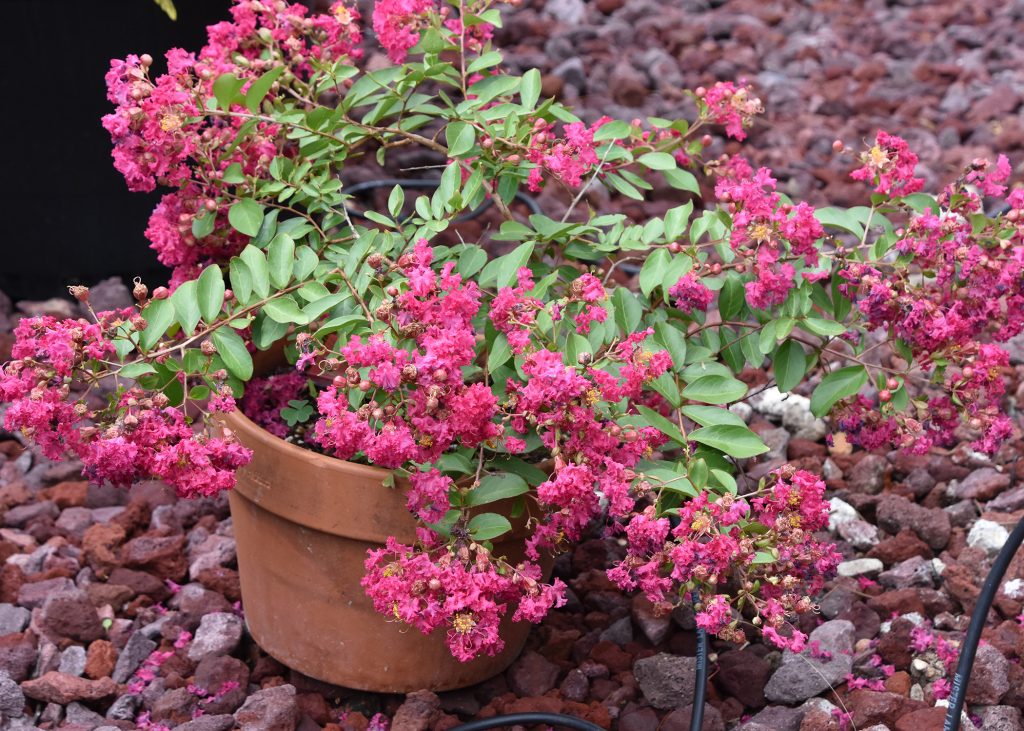
Crape Myrtle, or crepe myrtle, belongs to the Lythraceae family and showcases stunning flowers, peeling bark, and foliage that changes color in autumn. With varieties ranging from shrubs to small trees, Crape Myrtles are an excellent addition to any backyard. The Eastern Redbud boasts striking pink, reddish, and purple flowers that appear before the leaves in early spring, creating a captivating focal point. As summer arrives, legume-like fruits take their place. The Eastern Redbud requires full sun, well-drained soil, and regular watering to thrive. Additionally, proper pruning ensures healthy growth and structure. With their bright-colored flowers and varying heights, Eastern Redbuds are irresistible to hummingbirds.
Common Name: Eastern Redbud, Crape Myrtle
Scientific Name: Cercis canadensis
Growing Zones: 4 – 9
Sun: Full sun
Soil: Well-drained, slightly acidic
Colors: Pink, reddish, purple
Height: 20 – 30 feet
Spread: 25 – 35 feet
Plant Type: Small deciduous tree
10. Delicate Salvia
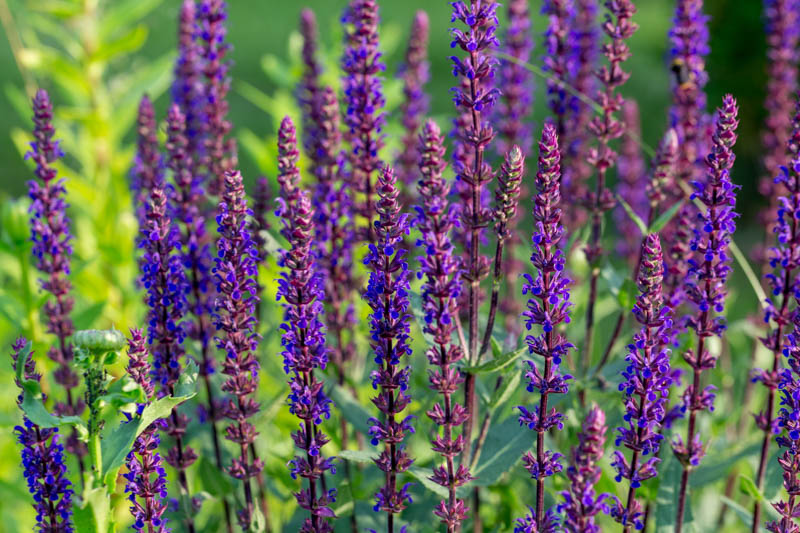
Salvia, a genus in the mint family, Lamiaceae, encompasses more than 900 species. These flowering plants are widely known for their showy spikes of tubular flowers and aromatic foliage. Many salvia varieties feature purple flowers that hummingbirds find particularly enticing. The blooms can range in shades of lavender, violet, and deep purple. Salvia plants prefer full sun and well-drained soil, making them suitable for rock gardens, borders, and containers. These low-maintenance plants attract hummingbirds and other pollinators while adding a touch of elegance to your garden.
Common Name: Salvia, sage
Scientific Name: Salvia
Growing Zones: Varies by species
Sun: Full sun
Soil: Well-drained
Colors: Purple, lavender, violet
Height: Varies by species
Spread: Varies by species
Plant Type: Perennial, Annual
11. Enchanting Lavender Haze – Penstemon
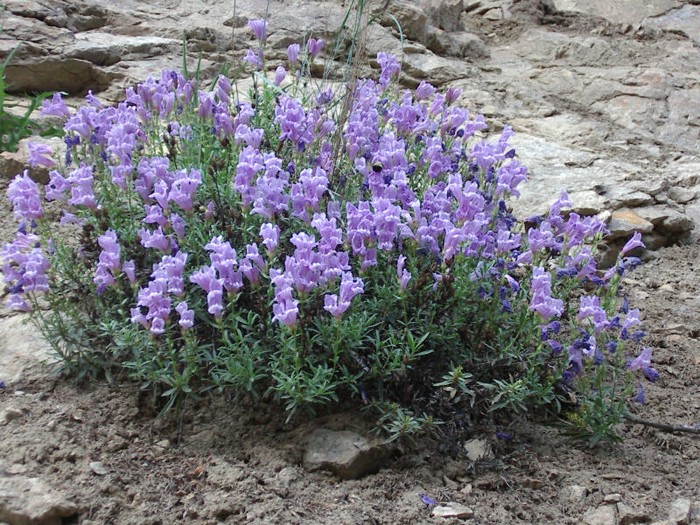
Penstemon, also known as Beardtongue, is a captivating genus of flowering plants comprising over 250 different species. These herbaceous perennials are native to North America and are often referred to as “hummingbird mints” due to their ability to attract these tiny birds with their vibrant blossoms. Penstemons come in a variety of sizes and colors, but they all share common traits—they are drought-tolerant, easy to care for, and their stunning blooms add a touch of charm to any garden.
Penstemon flowers bloom in early summer, forming eye-catching clusters of tubular flowers atop spires. These clusters showcase a splendid array of colors, including blue, purple, red, orange, white, pink, and yellow. Hummingbirds are particularly drawn to these vibrant hues and can’t resist indulging in the nectar-filled blossoms.
To cultivate Penstemons, it’s best to start them as indoor plants in May and then transplant them into your flower beds once summer arrives. These resilient plants thrive in full sun and lean, well-drained soil. While they can tolerate drought conditions, it’s beneficial to provide them with regular watering during their establishment phase. By selecting the right Penstemon varieties for your soil type and climate, you’ll ensure their longevity and enjoy the delightful presence of hummingbirds in your garden.
Common Name: Penstemon, Beardtongue
Scientific Name: Penstemon
Growing Zones: 3 – 9
Sun: Full sun
Soil: Lean, well-drained
Colors: Blue, purple, red, orange, white, pink, yellow
Height: 6 to 12 inches, 1 to 3 feet, 3 to 8 feet (varies by species)
Spread: 8 to 20 inches (varies by species)
Plant Type: Perennial
12. Majestic Morning Splendor – Morning Glory
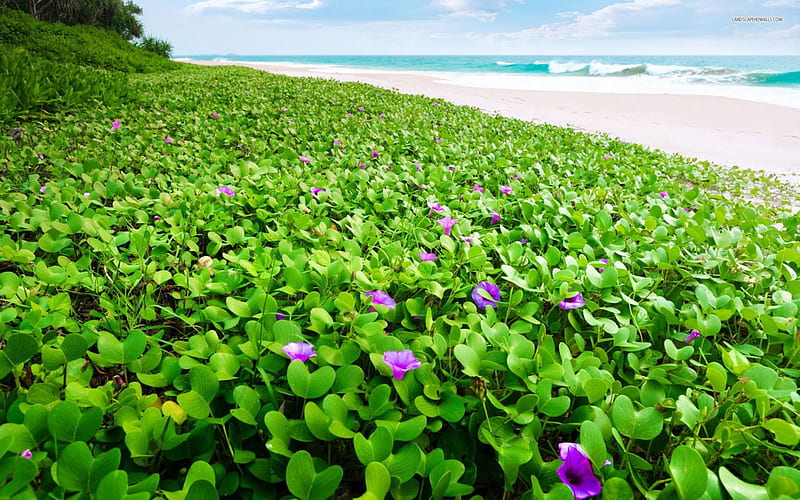
With over 1,000 species in the Convolvulaceae family, Morning Glory plants offer a diverse selection of vibrant and enchanting flowers. The name “Morning Glory” is derived from their unique characteristic of unfurling their colorful blooms early in the morning, creating a breathtaking display. While most Morning Glory species exhibit this behavior, some variants bloom during the night. Morning Glory plants are beloved for their fast-growing vines, bright green foliage, and ability to thrive in poor and dry soils.
One popular species that attracts hummingbirds is Ipomoea purpurea. This Morning Glory variety boasts stunning trumpet-shaped flowers in bright purple hues, which open in the morning and close in the afternoon. Blooming from early summer to early fall, these flowers are a delightful sight for both humans and hummingbirds.
Morning Glory is an annual vine, though it may act as a perennial in milder climates. To ensure full blooms, Morning Glory plants require at least eight hours of direct sunlight each day. Moist, well-draining soil is essential for their growth. However, it’s important to note that Morning Glory vines can become invasive if not properly maintained. Additionally, the seeds of some Morning Glory species are toxic if ingested, so caution should be exercised around children and pets.
Common Name: Morning Glory
Scientific Name: Convolvulaceae family
Growing Zones: 2 – 11
Sun: Full sun
Soil: Moist, well-draining
Colors: White, pink, purple, blue
Height: 6 – 10 feet tall
Spread: 3 – 6 feet wide
Plant Type: Annual
13. Radiant Elegance – Fuchsia
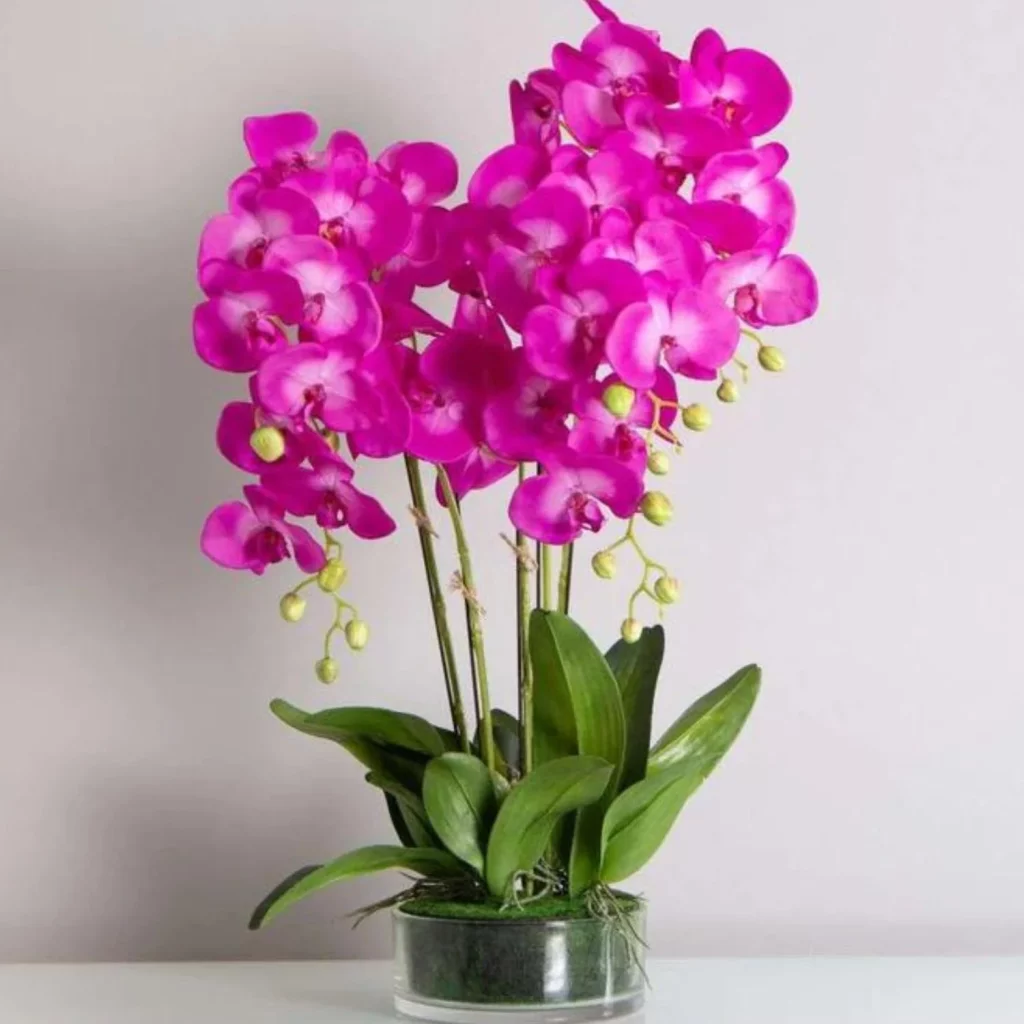
Fuchsias are radiant, hardy perennials renowned for their vibrant, pendulous flowers. These eye-catching blooms are particularly alluring to hummingbirds and can brighten up any garden, especially when displayed in pots and containers. Fuchsias thrive in a variety of soil types and require minimal maintenance, making them a delightful addition to your outdoor space.
Featuring a range of colors, including pink, purple, white, orange, and blue, Fuchsias are sure to attract the attention of hummingbirds. These flowers prefer dappled shade and moderate temperatures, making them an excellent choice for partially shaded areas of your patio or garden.
To care for Fuchsias, pinch off the growing tips after flowering and provide regular fertilization every two weeks during the growing season. In colder regions, they may need to be brought indoors during winter to protect them from freezing temperatures. By incorporating Fuchsias into your garden, you’ll not only create a charming space for hummingbirds but also enjoy their exquisite beauty throughout the season.
Common Name: Fuchsia
Scientific Name: Fuchsias
Growing Zones: 6 – 11
Sun: Partial sun to shade
Soil: Well-drained, moist
Colors: Pink, purple, white, orange, blue
Height: 1 – 3 feet
Spread: 1 – 5 feet
Plant Type: Perennial
14. Heavenly Eastern Blossom – Eastern Redbud
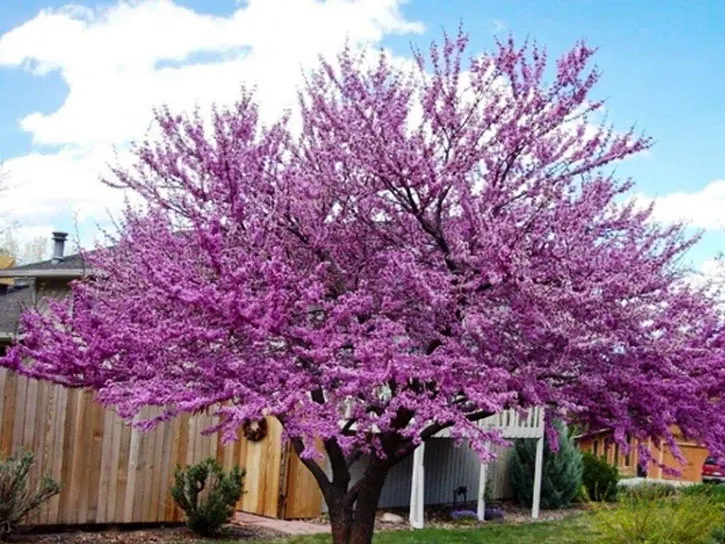
The Eastern Redbud, scientifically known as Cercis canadensis, is a stunning deciduous shrub or small tree native to eastern North America. Revered for its twisted trunk, zigzag branches, heart-shaped leaves, and beautiful flowers, the Eastern Redbud serves as an ideal ornamental specimen plant for smaller to medium-sized backyards.
What makes the Eastern Redbud truly enchanting is its early spring bloom. Prior to leafing out, the tree adorns itself with clusters of half-inch wide flowers, showcasing shades of light pink, deep magenta, and even purplish tinges. These delicate blossoms, which attract hummingbirds and long-tongued bees, seem to float in the air against the backdrop of dark branches and trunk. Their beauty can be enjoyed for two to three weeks before the emergence of fruits.
As summer approaches, the Eastern Redbud reveals its green heart-shaped leaves, adding another layer of visual interest. When winter arrives, these leaves transform into winter buds, displaying a vibrant mix of bright green and red hues. The tree’s fruits, resembling bean pods, eventually appear and transition from green to brown as winter progresses.
Eastern Redbuds thrive in full sun or partial shade, and while they can tolerate drought, regular watering is advisable during the establishment phase. Pruning when young helps shape and structure the tree. With its captivating flowers and distinctive features, the Eastern Redbud creates a heavenly atmosphere in any garden while attracting the delightful presence of hummingbirds.
Common Name: Eastern Redbud
Scientific Name: Cercis canadensis
Growing Zones: 4 – 9
Sun: Full sun, partial shade
Soil: Moist, well-drained
Colors: Pink, reddish, purple
Height: 20 – 30 feet tall
Spread: 25 – 35 feet wide
Plant Type: Small deciduous tree
15. Serene Azure Delight – Morning Glories
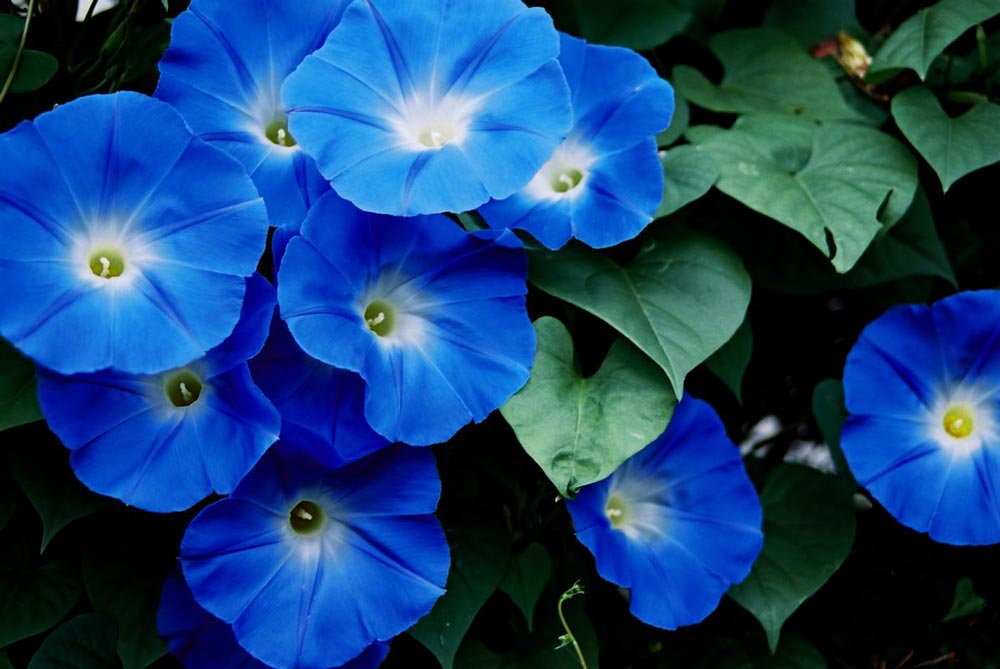
Morning Glories, members of the Convolvulaceae family, encompass a vast array of flowering plants. Boasting over 1,000 species, Morning Glories captivate with their charming blossoms that unfurl early in the day, adding a touch of serenity to any garden. While most Morning Glory species bloom in the morning, some bloom at night, such as Ipomoea alba.
Morning Glory plants are known for their rapid growth, lush vines
, and ability to tolerate poor, dry soils. Twining around arbors or crawling along exterior walls with the support of trellises, Morning Glories create a picturesque display.
One species that particularly attracts hummingbirds is Ipomoea purpurea. These Morning Glories feature trumpet-shaped flowers in vivid purple hues that open in the morning and close in the afternoon. Blooming from early summer to early fall, these charming flowers delight both humans and hummingbirds alike.
While Morning Glories are typically annual vines, some varieties may behave as perennials in milder climates. To ensure optimal growth, Morning Glories require at least eight hours of direct sunlight each day. Moist, well-draining soil is essential for their development. It’s important to note that without proper maintenance, Morning Glory vines can become invasive. Additionally, some Morning Glory seeds are toxic if ingested, necessitating caution around children and pets.
Common Name: Morning Glory
Scientific Name: Convolvulaceae family
Growing Zones: 2 – 11
Sun: Full sun
Soil: Moist, well-draining
Colors: White, pink, purple, blue
Height: 6 – 10 feet tall
Spread: 3 – 6 feet wide
Plant Type: Annual
16. Enchanting Twilight Dancers – Nicotiana

Step into a world of enchantment with the mesmerizing flowering tobacco plants, scientifically known as Nicotiana. These herbaceous plants, distant relatives of true tobacco, are cultivated primarily for their ornamental value and come in a variety of captivating forms.
For a garden filled with the intoxicating fragrance of jasmine, consider the popular varieties Nicotiana sylvestris or Nicotiana alata. As the evening descends, these exquisite plants release a delicate jasmine scent, creating a magical atmosphere.
Nicotiana sylvestris boasts wide, oblong leaves, while a central flower spike gracefully ascends from its center, reaching impressive heights. Pendant tubular flowers in shades of white or cream adorn the plant from June until the first frost, captivating both humans and hummingbirds. On the other hand, Nicotiana alata features elegant, tubular flowers on tall stems, emitting a sweet perfume during the night.
These enchanting varieties of flowering tobacco are relatively easy to grow, requiring full sun or partial shade and well-draining soil. With their tubular flowers and irresistible fragrance, they are irresistible to hummingbirds, inviting these delightful creatures to dance amidst your garden.
Common Name: Flowering tobacco, Jasmine tobacco
Scientific Name: Nicotiana family
Growing Zones: 10 – 11
Sun: Full sun to part shade
Soil: Organically-rich, moist, well-draining
Colors: White, yellow, pink, red, yellow-green, purple
Height: 6 to 12 inches, 1 to 3 feet, 3 to 8 feet, 8 to 20 feet tall
Spread: 6 inches to 10 feet, depending on the variety
Plant Type: Annual
17. Vibrant Kaleidoscope Blooms – Zinnias
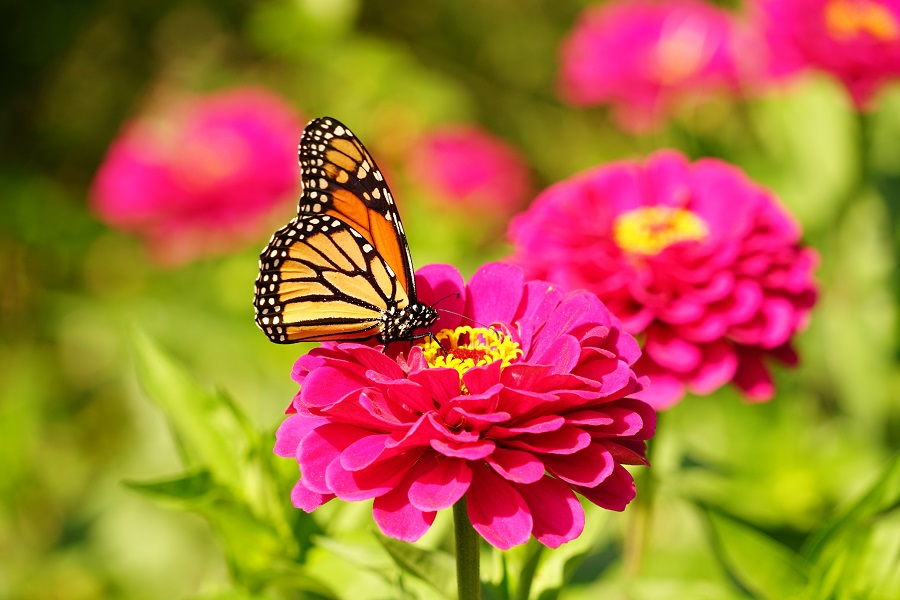
Immerse yourself in a vibrant kaleidoscope of colors with Zinnias, exquisite flowering shrubs native to the scrub and dry grasslands of North America. Belonging to the Heliantheae genus within the vast daisy family, Asteraceae, Zinnias are a captivating addition to any garden.
Zinnias delight in displaying their intricate petals, with three main types to choose from. Single-flowered Zinnias boast a single row of petals surrounding a visible center, while double-flowered Zinnias showcase numerous layers of petals without a central disc. Semi-double-flowered Zinnias present an enchanting combination of multiple rows of petals with visible centers.
The classic Zinnia elegans stands tall with its bright hues and captivating charm, reaching heights of up to 4 feet. These brilliantly colored flowers bloom abundantly from early summer until the arrival of frost, beckoning butterflies, hummingbirds, and other pollinators to indulge in their nectar-rich blooms.
Growing Zinnias is a joyful endeavor, although they prefer to be sown directly in their designated spot as they dislike transplanting. Embracing full sun and well-draining soil, these remarkable blooms will grace your garden with their beauty throughout the season.
Common Name: Zinnia
Scientific Name: Zinnia elegans
Growing Zones: Annuals in 2-8, Perennials in 9-11
Sun: Full sun
Soil: Neutral to slightly alkaline, well-draining
Colors: White, yellow, orange, pink, red, purple
Height: 1 – 4 feet tall
Spread: 12 – 18 inches wide
Plant Type: Annual, Perennial Shrubs
18. Timeless Elegance – Daylilies
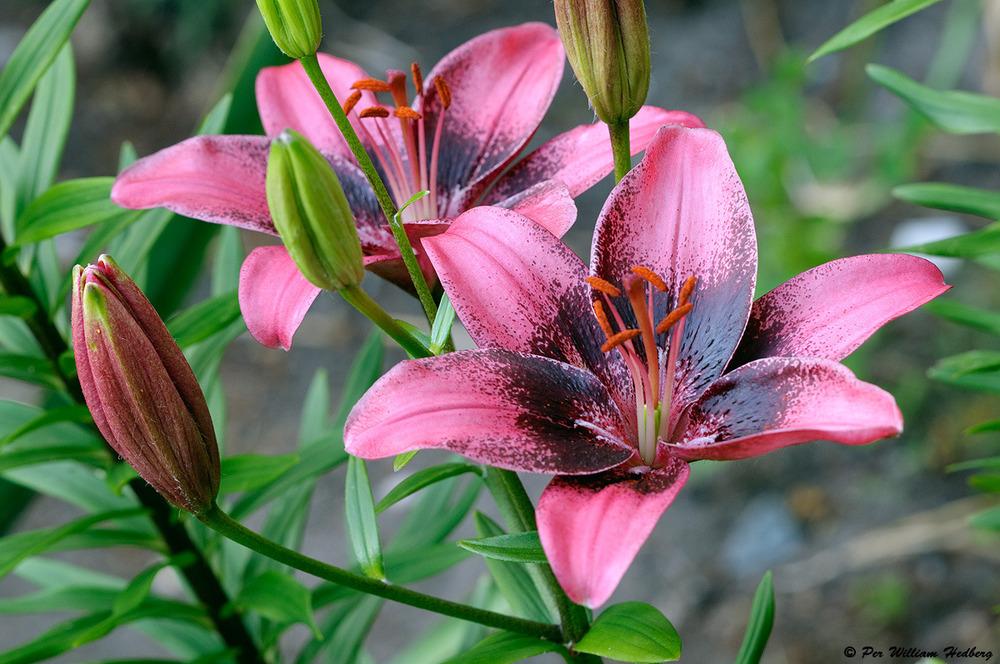
Discover the timeless elegance of Daylilies, perennial plants from the Asphodelaceae family that have captured the hearts of
garden enthusiasts. With over 35,000 cultivars developed to enhance their colors, hardiness, and disease resistance, Daylilies offer a vast array of stunning options.
Contrary to their name, Daylilies are not true lilies. They emerge from fleshy roots rather than onion-like bulbs and produce exquisite flowers on leafless stems known as scapes. Each mature Daylily plant may bear 4 to 6 scapes, each adorned with 12 to 15 buds, providing an abundance of blooming flowers from mid-spring to fall.
While individual Daylily flowers only last a day, their continuous production ensures a prolonged flowering season. Placing them in a sun-drenched area that receives at least six hours of sunlight will encourage their brilliant-colored blooms. Adequate hydration, especially during scape and bud formation, will ensure these stunning flowers grace your garden year after year.
The vibrant colors of Daylilies, particularly the reds and purples, act as beacons to hummingbirds. Their tubular varieties hold a bountiful supply of nectar, drawing these delightful birds for a delightful feast.
Common Name: Daylily
Scientific Name: Genus Hemerocallis
Growing Zones: 4 – 9
Sun: Full sun
Soil: Slightly acidic to neutral
Colors: White, yellow, orange, pink, red, purple
Height: 3 to 4 feet tall
Spread: 2 to 4 feet wide
Plant Type: Perennial
19. Miniature Petunias – Calibrachoa
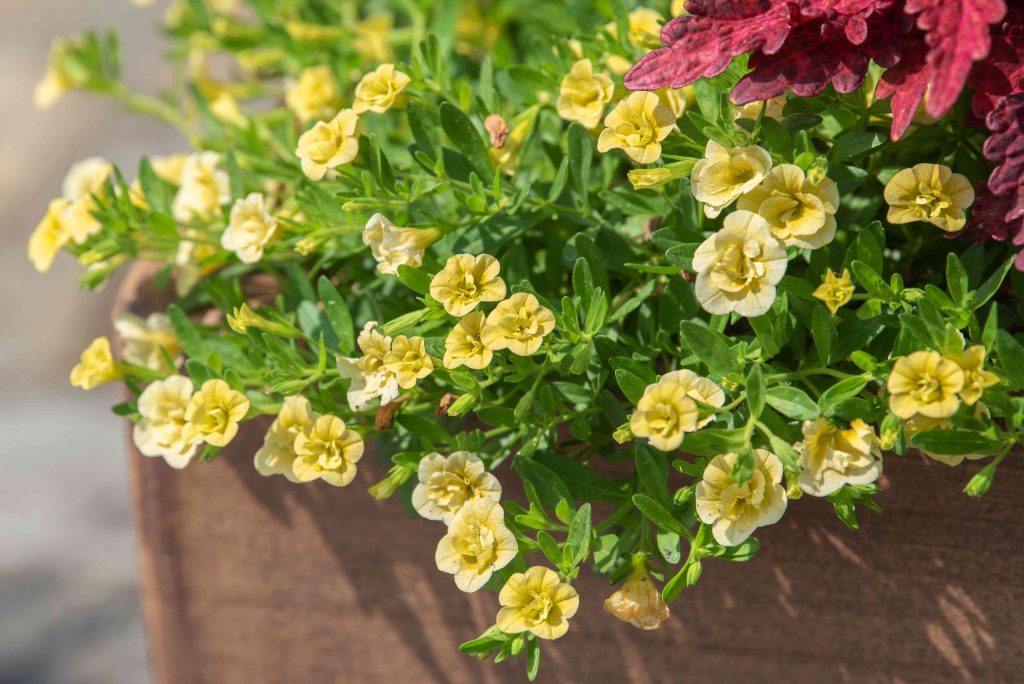
Introducing the captivating Calibrachoa, a relatively new addition to the world of ornamental plants that has quickly gained popularity. Commonly known as “million bells” or “trailing petunia,” these small shrubs from the Solanaceae family display an abundance of colorful blooms reminiscent of miniature petunias.
Calibrachoa plants are a sight to behold, cascading gracefully from containers and hanging baskets. Despite their compact size, reaching a maximum height of 12 inches, they produce a profusion of flowers that will enchant any observer, leaving little room for foliage.
The bell-shaped flowers of Calibrachoa come in a stunning array of colors, including coral, yellow, orange, red, pink, blue, purple, burgundy, lavender, and cream. Some varieties even boast dual-colors, veined petals, and segmented blooms. The vivid hues and intricate patterns of Calibrachoa flowers are irresistible to hummingbirds and other pollinators.
Thriving in full sun and well-draining soil, Calibrachoa is a relatively low-maintenance plant. Monitoring the temperature is essential, as extreme heat may require adjustments to watering. With their prolific and vibrant blooms, Calibrachoa adds a delightful touch to any garden or hanging arrangement.
Common Name: Calibrachoa, million bells, trailing petunia, mini petunia
Scientific Name: Calibrachoa
Growing Zones: 9 – 11
Sun: Full sun to part shade
Soil: Moist, rich, well-drained
Colors: Coral, yellow, orange, red, pink, blue, purple, burgundy, lavender, cream
Height: 6 – 12 inches tall
Spread: 12 – 24 inches wide
Plant Type: Perennial
20. Majestic Spikes of Beauty – Delphinium
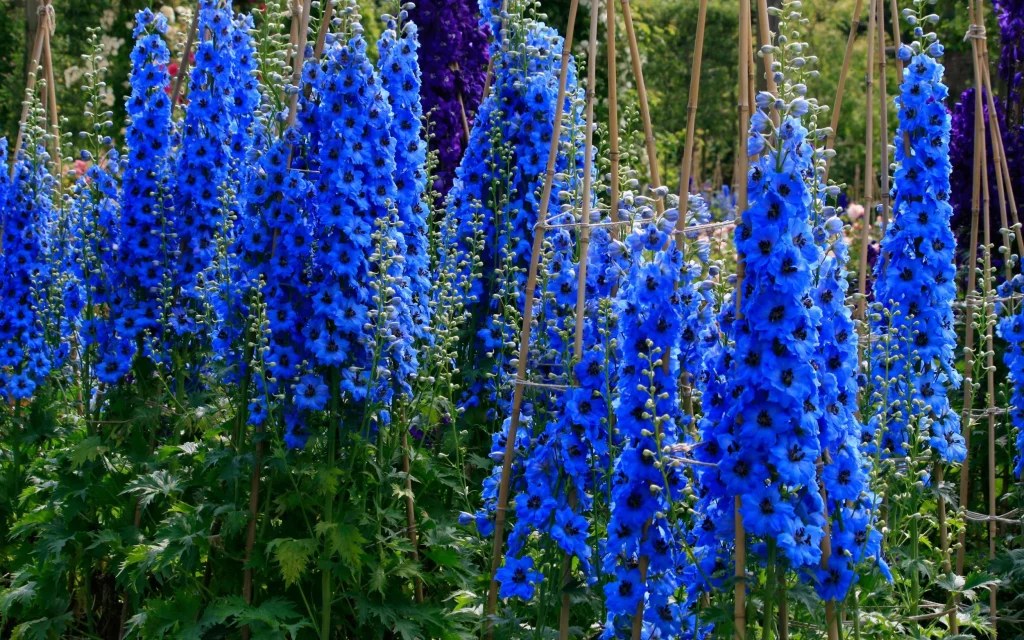
Prepare to be captivated by the majestic beauty of Delphiniums, a genus of flowering plants belonging to the family Ranunculaceae. With approximately 300 species to their name, Delphiniums are renowned for their tall, colorful, and nectar-rich flowers, making them a haven for butterflies, bees, and hummingbirds.
While Delphiniums have gained popularity for their rare blue flowers, they also come in enchanting shades of pink and red. Their vibrant blooms can be enjoyed from late spring to late summer, injecting bursts of color into any garden.
Delphiniums can tower up to 8 feet tall, accompanied by attractive foliage consisting of small, palm-shaped leaves. To support their vertical growth and protect them from strong winds, providing sturdy stakes is often necessary.
With their generous clusters of flowers, Delphiniums offer an abundant source of nectar that entices hummingbirds to visit repeatedly. The bright and vivid colors of these flowers are a visual feast, drawing in these delightful birds for a delightful treat.
Common Name: Larkspur, Delphinium
Scientific Name: Delphinium
Growing Zones: 3 – 7
Sun: Full sun, part shade
Soil: Well-draining soil
Colors: White, pink, red, purple, blue
Height: 1 to 3 feet tall, 3 to 8 feet tall
Spread: 1 to 3 feet wide
Plant Type: Perennial
21. Nature’s Nitrogen Fixers – Lupines

Step into a world of ecological balance with the fascinating Lupines, scientifically known as Lupinus. Belonging to the Fabaceae family, Lupines have approximately 199 species of flowering plants, primarily native to the temperate Northern Hemisphere.
Lupines have a remarkable ecological role as nitrogen-fixing plants
, enriching the soil naturally. Originally dubbed “lupinus” due to the misconception that they depleted soil nutrients like wolves, they, in fact, contribute nitrogen to the soil, benefiting neighboring plants in need of this vital nutrient.
Among the diverse array of Lupine species, the Texas bluebonnet (Lupinus texensis) stands out in the United States for its abundant blue flower spikes. These captivating blooms have earned Lupines the popular name of “bluebonnet.”
Lupines boast an extensive color palette, ranging from blue and white in the wild to blue, yellow, pink, red, and purple in cultivated varieties. The tubular shapes of their flowers, particularly appealing to hummingbirds, serve as a beacon, attracting these exquisite birds to their abundant nectar.
Common Name: Lupin, Lupine, Bluebonnet
Scientific Name: Lupinus
Growing Zones: 4 – 8
Sun: Full sun
Soil: Rich, moist, well-drained
Colors: White, pink, red, yellow, blue, purple, bicolor
Height: 3 – 4 feet tall
Spread: 1 – 1.5 feet wide
Plant Type: Annual, Perennial
22. A Haven for Pollinators – Bee Balm
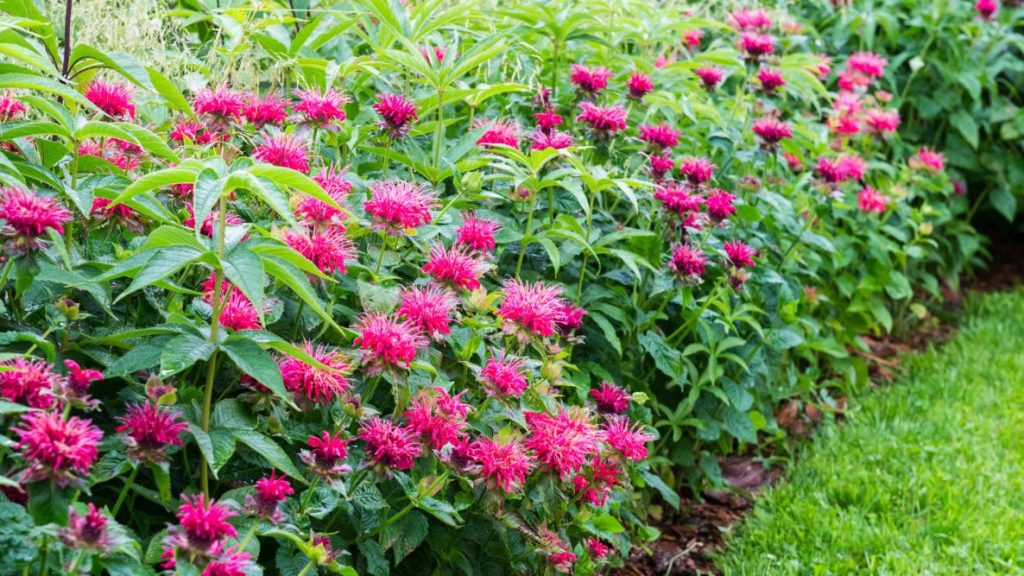
Discover the enchanting world of Bee Balm, a member of the Monarda mint family, scientifically known as Monarda from the Lamiaceae family. Its common name, Bee Balm, stems from Native Americans’ use of its leaves as an antiseptic balm for bee stings. Additionally, the Oswego Native Americans brewed its leaves into a delightful tea, hence its alternative name, “Oswego Tea.”
Bee Balm plants are not only cherished for their aromatic, minty leaves but also for their vibrant, exotic-looking flowers that are a true paradise for hummingbirds. Among the various Monarda species, Monarda didyma stands out with its scarlet-red flowers, preferred by these captivating birds. The bright-red, tubular blooms grace the garden from mid-summer to early fall, creating a stunning visual display.
Thriving under full sun but also tolerating partial shade during hot weather, Bee Balm prefers moist, well-drained soil. Adequate watering, especially during the formation of scapes and buds, ensures healthy growth. Planting Bee Balm in your garden offers a multitude of benefits: fragrant leaves for culinary uses, vibrant, long-lasting flowers, and the attraction of hummingbirds and other pollinators. Additionally, you can create your own essential oils from its leaves for various medicinal purposes.
Common Name: Bergamot, Bee Balm, Horsemint, Oswego Tea
Scientific Name: Monarda from the Lamiaceae mint family
Growing Zones: 4 – 9
Sun: Full sun, partial shade
Soil: Rich, moist, well-drained
Colors: White, pink, red, purple
Height: 2 – 4 feet tall
Spread: 2 – 3 feet wide
Plant Type: Perennial
23. Delight in Colorful Cones – Coneflower
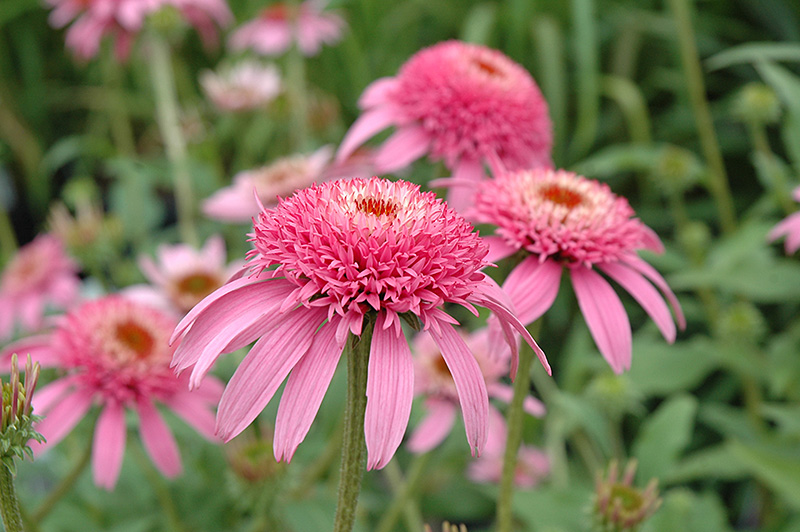
Prepare to be dazzled by the exquisite beauty of Coneflower, scientifically known as Echinacea, a genus of flowering plants in the Asteraceae family. The name “Echinacea” originates from the Greek word for “sea urchin,” inspired by its shiny central disk resembling these marine creatures.
Coneflowers comprise ten species, each displaying a charming cone-shaped flower head. The most popular among them is Echinacea purpurea, also known as the purple coneflower, native to eastern North America. While renowned for their rare blue flowers, coneflowers also enchant with hues of pink, red, orange, yellow, and white, depending on the variety. These captivating blooms, adorning sturdy stalks reaching heights of up to 5 feet, bring life and vibrancy to the garden.
Coneflowers thrive in full sun and well-drained soil, providing a long-lasting display of color from summer to fall. The radiant, nectar-rich flowers serve as a magnet for hummingbirds, bees, and butterflies, ensuring a continuous flurry of activity in your garden. Their central cones hold a reservoir of nectar, attracting these delightful pollinators for a delightful feast.
Common Name: Coneflower
Scientific Name: Echinacea
Growing Zones: 3 – 9
Sun: Full sun
Soil: Varies
Colors: White, yellow, orange, pink, red, purple, green
Height: 2 to 5 feet tall
Spread: 1 ½ – 2 feet wide
Plant Type: Perennial
24. Vibrant Beauty of Phlox

Prepare to be dazzled by the vibrant beauty of Phlox, a genus of flowering plants that encompasses various species, including Creeping Phlox (Phlox subulata), Woodland Phlox (Phlox
stolonifera/divaricata), and Garden Phlox (Phlox paniculata). Each type offers its unique charm to captivate garden enthusiasts.
Creeping Phlox forms a low, sprawling carpet of flowers, making it an ideal ground cover. Woodland Phlox, with its medium height, fills gaps with grace, while Garden Phlox stands tall and erect, demanding attention even from the back of the garden.
Phlox flowers gather in clusters atop hardy stems, releasing their delicate fragrance. With an extensive color range encompassing shades of white, pink, red, purple, and blue, these flowers are a delightful sight to behold. While their abundant blooms often overshadow the foliage, Phlox leaves possess their own allure, with oblong or lance-shaped forms and vivid shades of green.
Hummingbirds and other pollinators are irresistibly drawn to the profusion of Phlox flowers. These plants are easy to grow, requiring minimal maintenance. Given regular watering and full sunlight, they will reward you with a breathtaking display of vibrant blooms.
Common Name: Garden Phlox, Creeping Phlox, Woodland Phlox
Scientific Name: Phlox
Growing Zones: 2 – 9
Sun: Full sun, part sun, shade
Soil: Moist, fertile soil with a layer of compost
Colors: White, pink, red, purple, blue
Height: 4 to 6 inches, 8 to 12 inches, 2 to 4 feet tall
Spread: 4 to 6 inches wide, 8 to 12 inches wide, 2 to 3 feet wide
Plant Type: Perennial
25. Elegance in Bloom – Veronica
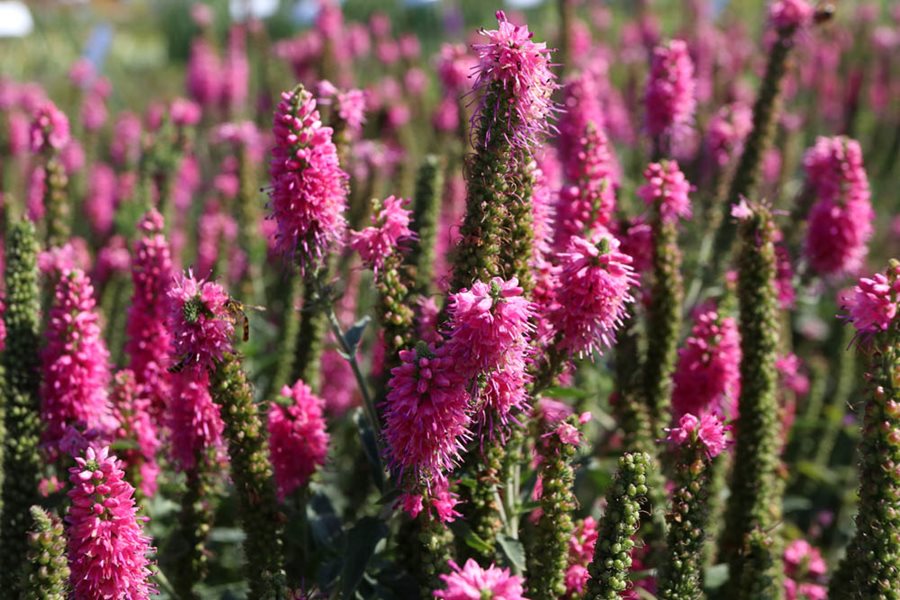
Unleash the elegance of Veronica, a genus of flowering plants boasting approximately 500 species, making it the largest genus in the Plantaginaceae family. These herbaceous annuals or perennials are native to the temperate Northern Hemisphere.
Veronica presents an array of captivating varieties, from low-growing ground covers that bloom in spring to tall, vertical flower spikes that grace the garden during summer. Among the diverse Veronica species, Veronica spicata stands out with its stunning vertical spikes adorned with tiny, clumped flowers in shades of white, pink, purple, and blue. These captivating blooms not only add charm to your garden but also attract hummingbirds, butterflies, and bees.
Speedwells, as they are also known, thrive in various soil conditions, displaying their hardiness and adaptability. With minimal pest issues and the ability to extend their flowering season through deadheading, Veronicas are a joy to cultivate. Embracing full sunlight and regular watering, these plants reward your efforts with a captivating tapestry of colorful blooms.
Common Name: Veronica, Speedwell
Scientific Name: Genus Veronica from the Plantaginaceae family
Growing Zones: 3 – 11
Sun: Full sun, partial shade
Soil: Well-drained
Colors: White, pink, purple, blue
Height: 6 inches to 3 feet tall
Spread: 6 inches to 2 feet wide
Plant Type: Perennial